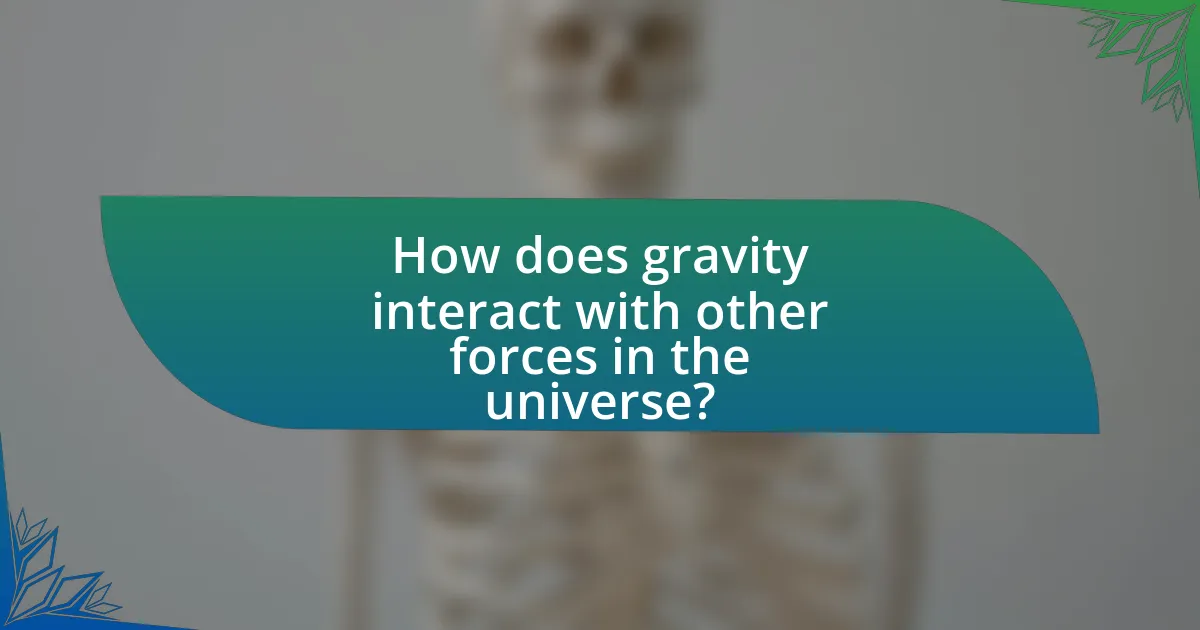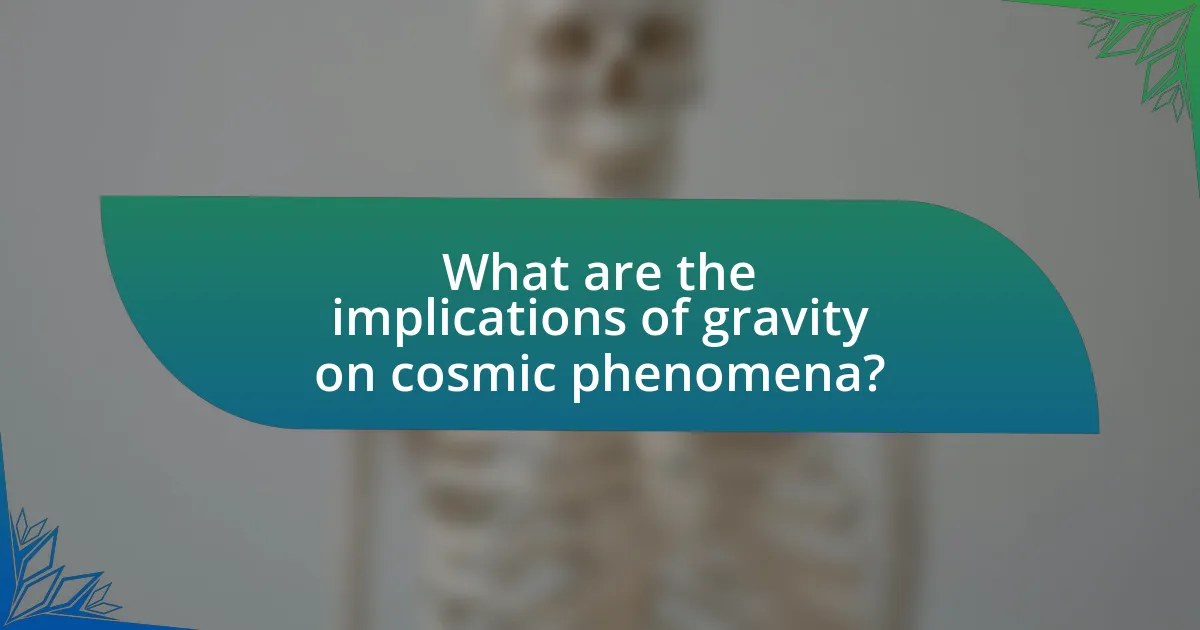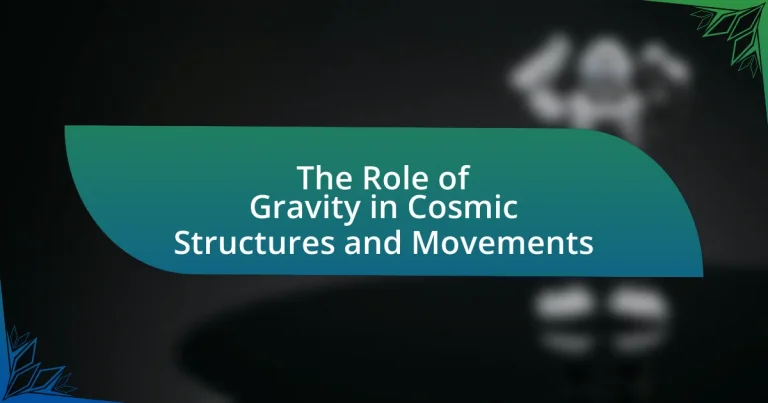Gravity is the fundamental force that shapes cosmic structures and governs their movements, playing a crucial role in the formation of galaxies, stars, and planetary systems. It attracts matter together, leading to the coalescence of gas and dust, and influences the dynamics of celestial bodies, dictating their orbits and interactions. Key cosmic structures affected by gravity include galaxies, galaxy clusters, and stars, with gravity providing stability and influencing the lifecycle of these entities. Additionally, gravity interacts with other fundamental forces, affects the expansion of the universe, and is essential for understanding phenomena such as black holes and gravitational lensing. This article explores the multifaceted role of gravity in the universe, highlighting its significance in cosmic evolution and structure.

What is the Role of Gravity in Cosmic Structures and Movements?
Gravity is the fundamental force that shapes cosmic structures and governs their movements. It acts as the primary mechanism for the formation of galaxies, stars, and planetary systems by attracting matter together, leading to the coalescence of gas and dust into denser regions. This process is evidenced by the gravitational collapse of molecular clouds, which results in star formation, as described in the research by Larson (2003) in “The Formation of Stars and Planets” published in the Annual Review of Astronomy and Astrophysics. Additionally, gravity influences the dynamics of celestial bodies, dictating their orbits and interactions, as seen in the gravitational binding of galaxies within clusters and the orbital mechanics of planets around stars. The precise measurements of gravitational effects, such as those observed in gravitational lensing, further validate the role of gravity in the structure and movement of the universe.
How does gravity influence the formation of cosmic structures?
Gravity is the fundamental force that drives the formation of cosmic structures by attracting matter together. As matter in the universe begins to clump due to gravitational attraction, it forms larger structures such as galaxies, galaxy clusters, and eventually superclusters. This process is supported by the observation that regions of higher density in the early universe led to the formation of stars and galaxies, as evidenced by simulations and studies of cosmic microwave background radiation, which show fluctuations that correspond to the gravitational pull of matter.
What are the key cosmic structures affected by gravity?
The key cosmic structures affected by gravity include galaxies, galaxy clusters, stars, and planetary systems. Gravity is the fundamental force that governs the formation and dynamics of these structures, influencing their interactions and stability. For instance, galaxies are held together by gravitational attraction among their stars and dark matter, while galaxy clusters are formed through the gravitational pull of multiple galaxies. Additionally, stars form from the gravitational collapse of gas and dust in molecular clouds, and planetary systems develop through the gravitational interactions within protoplanetary disks. These relationships illustrate the pervasive influence of gravity across various scales in the universe.
How does gravity contribute to the stability of these structures?
Gravity contributes to the stability of cosmic structures by providing the necessary force that holds matter together, preventing disintegration. In large-scale structures like galaxies and galaxy clusters, gravity acts as the dominant force, attracting stars, gas, and dark matter, which collectively form a cohesive entity. This gravitational binding ensures that these structures maintain their integrity over time, resisting external forces and internal turbulence. For instance, the Milky Way galaxy’s stability is largely due to the gravitational pull of its mass, which keeps stars in orbit and maintains the overall structure against disruptive influences.
Why is gravity essential for the movement of celestial bodies?
Gravity is essential for the movement of celestial bodies because it is the fundamental force that governs their attraction and interaction. This force causes planets, moons, and stars to orbit one another, maintaining the structure of solar systems and galaxies. For instance, the gravitational pull of the Sun keeps the planets in their respective orbits, preventing them from drifting into space. Additionally, gravity influences the formation of celestial bodies, as it causes gas and dust in space to coalesce into stars and planets. The laws of motion and universal gravitation, formulated by Isaac Newton, provide the mathematical framework that describes these interactions, confirming that gravity is the key force behind the dynamics of celestial movements.
What role does gravity play in the orbits of planets and moons?
Gravity is the fundamental force that governs the orbits of planets and moons, providing the necessary centripetal force to keep them in their elliptical paths around larger celestial bodies. The gravitational attraction between a planet and its moon, or a planet and the sun, creates a balance between the inertia of the orbiting body and the pull of gravity, resulting in stable orbits. For instance, the Earth’s gravity keeps the Moon in orbit at an average distance of about 384,400 kilometers, while the Sun’s gravity maintains the Earth’s orbit at approximately 149.6 million kilometers. This relationship is described by Kepler’s laws of planetary motion, which illustrate how gravity influences the speed and shape of orbits, confirming that gravity is essential for the stability and structure of our solar system.
How does gravity affect the motion of galaxies and galaxy clusters?
Gravity governs the motion of galaxies and galaxy clusters by exerting a force that influences their trajectories and interactions. This gravitational force causes galaxies to attract one another, leading to phenomena such as galaxy mergers and the formation of larger structures known as galaxy clusters. Observations show that galaxies within clusters move at high velocities, with their motion dictated by the gravitational pull of the cluster’s mass, including dark matter, which constitutes a significant portion of the total mass. Studies, such as those conducted by the Hubble Space Telescope, have measured the velocities of galaxies in clusters, confirming that their motion aligns with predictions based on gravitational dynamics.

How does gravity interact with other forces in the universe?
Gravity interacts with other fundamental forces in the universe by influencing their effects on matter and energy. Specifically, gravity is one of the four fundamental forces, alongside electromagnetism, the weak nuclear force, and the strong nuclear force. It governs the large-scale structure of the universe, affecting the motion of celestial bodies and the formation of galaxies, while electromagnetism governs atomic and molecular interactions.
For example, gravity causes the attraction between massive objects, such as planets and stars, which can lead to the formation of orbits. This gravitational interaction is essential for the stability of planetary systems and the dynamics of galaxies. Additionally, gravity can influence the behavior of light, as seen in gravitational lensing, where massive objects bend the path of light due to their gravitational field, demonstrating the interplay between gravity and electromagnetic forces.
The relationship between gravity and other forces is further illustrated in the context of general relativity, where gravity is described as the curvature of spacetime caused by mass. This framework shows how gravity interacts with the fabric of the universe, affecting the propagation of light and the behavior of particles influenced by electromagnetic forces. Thus, gravity plays a crucial role in shaping cosmic structures and movements, highlighting its interaction with other fundamental forces.
What are the primary forces that interact with gravity?
The primary forces that interact with gravity are electromagnetism, the strong nuclear force, and the weak nuclear force. Electromagnetism affects charged particles and governs interactions between them, influencing the behavior of matter in gravitational fields. The strong nuclear force binds protons and neutrons in atomic nuclei, while the weak nuclear force is responsible for certain types of particle decay. These forces, while distinct from gravity, play crucial roles in the structure and dynamics of the universe, as they contribute to the formation of matter and the interactions that occur within gravitational fields.
How does gravity compare to electromagnetic forces in cosmic interactions?
Gravity is significantly weaker than electromagnetic forces in cosmic interactions. While gravity governs the large-scale structure of the universe, such as the formation of galaxies and the motion of celestial bodies, electromagnetic forces dominate at smaller scales, influencing atomic and molecular interactions. For instance, the gravitational force between two objects is proportional to their masses and decreases with distance, whereas electromagnetic forces can be much stronger, as evidenced by the interactions between charged particles, which can be millions of times more powerful than gravitational attraction at the same distance. This disparity in strength is crucial for understanding phenomena like star formation, where gravity pulls matter together, while electromagnetic forces dictate the behavior of atoms and molecules within that matter.
What is the significance of gravity in the context of dark matter?
Gravity is significant in the context of dark matter because it is the primary force that governs the behavior and distribution of dark matter in the universe. Dark matter, which constitutes approximately 27% of the universe’s total mass-energy content, does not emit, absorb, or reflect light, making it invisible and detectable only through its gravitational effects. Observations of galaxy rotation curves, such as those conducted by Vera Rubin in the 1970s, reveal that galaxies rotate at speeds that cannot be explained by the visible matter alone; this discrepancy indicates the presence of dark matter exerting gravitational influence. Additionally, gravitational lensing, observed in clusters of galaxies, provides further evidence of dark matter’s existence, as the bending of light from distant objects is consistent with the mass attributed to dark matter. Thus, gravity is essential for understanding the structure and dynamics of the universe, as it reveals the unseen mass that shapes cosmic formations.
How does gravity shape the evolution of the universe?
Gravity is the fundamental force that shapes the evolution of the universe by influencing the formation and dynamics of cosmic structures. It governs the attraction between masses, leading to the coalescence of matter into galaxies, stars, and planets. For instance, after the Big Bang, gravity caused gas and dust to collapse into denser regions, forming the first stars and galaxies approximately 400 million years later. This gravitational interaction continues to drive the expansion of the universe, as evidenced by observations of cosmic microwave background radiation and the distribution of galaxies, which indicate that gravity plays a crucial role in the large-scale structure of the cosmos.
What impact does gravity have on the expansion of the universe?
Gravity slows down the expansion of the universe by exerting an attractive force between masses. This force counteracts the effects of dark energy, which drives the accelerated expansion. Observations, such as those from the Cosmic Microwave Background radiation and galaxy clustering, indicate that gravity plays a crucial role in shaping the large-scale structure of the universe and influences its overall dynamics. The balance between gravitational attraction and the repulsive effect of dark energy determines the rate of expansion, as evidenced by the measurements of the Hubble constant and the distribution of galaxies.
How does gravity influence the lifecycle of stars?
Gravity is the fundamental force that governs the lifecycle of stars by initiating their formation, regulating their evolution, and ultimately determining their fate. During star formation, gravity causes gas and dust in molecular clouds to collapse, leading to the creation of protostars. As the protostar’s core temperature rises due to gravitational pressure, nuclear fusion ignites, marking the transition to the main sequence phase of a star’s life.
Throughout a star’s lifecycle, gravity balances the outward pressure from nuclear fusion. In massive stars, when hydrogen is depleted, gravity causes the core to contract and heat up, allowing fusion of heavier elements, which leads to the formation of red giants or supergiants. Eventually, gravity plays a crucial role in the star’s death; for low to medium mass stars, it leads to the shedding of outer layers and the formation of planetary nebulae, leaving behind white dwarfs. In contrast, for massive stars, gravity causes a catastrophic collapse, resulting in supernova explosions and the formation of neutron stars or black holes.
This gravitational influence is supported by observational evidence, such as the Hertzsprung-Russell diagram, which illustrates the relationship between a star’s luminosity and its temperature, reflecting the stages of stellar evolution influenced by gravity.

What are the implications of gravity on cosmic phenomena?
Gravity significantly influences cosmic phenomena by governing the formation, structure, and dynamics of celestial bodies and systems. It is the fundamental force that causes matter to clump together, leading to the formation of stars, galaxies, and larger structures in the universe. For instance, the gravitational attraction between particles in a molecular cloud initiates star formation, while the gravitational pull of galaxies affects their interactions and mergers, as evidenced by the observed collision of the Milky Way with the Andromeda Galaxy in approximately 4.5 billion years. Additionally, gravity plays a crucial role in the dynamics of planetary orbits, as described by Kepler’s laws of planetary motion, which illustrate how gravitational forces dictate the elliptical paths of planets around stars. Thus, gravity is essential for understanding the organization and evolution of the universe.
How does gravity contribute to the formation of black holes?
Gravity plays a crucial role in the formation of black holes by causing the collapse of massive stars under their own gravitational pull. When a star exhausts its nuclear fuel, it can no longer support itself against gravitational forces, leading to a rapid implosion. This process results in a singularity, where the gravitational pull becomes so intense that not even light can escape, thus forming a black hole. Theoretical models, such as those derived from Einstein’s General Theory of Relativity, support this understanding by illustrating how gravity influences the curvature of spacetime around massive objects, ultimately leading to the creation of black holes when sufficient mass is concentrated in a small volume.
What processes lead to the creation of a black hole due to gravitational collapse?
A black hole is created through the process of gravitational collapse, which occurs when a massive star exhausts its nuclear fuel and can no longer support itself against gravitational forces. As the star’s core collapses under its own gravity, it compresses to a point where density and gravitational pull become so intense that not even light can escape, resulting in a black hole. This process is supported by the theory of general relativity, which describes how mass warps spacetime, leading to the formation of singularities at the centers of black holes. Observational evidence, such as the detection of gravitational waves from merging black holes and the imaging of the event horizon of the black hole in the galaxy M87 by the Event Horizon Telescope, further validates this process.
How do black holes affect surrounding cosmic structures through their gravitational pull?
Black holes significantly affect surrounding cosmic structures through their intense gravitational pull, which can influence the motion and behavior of nearby stars, gas, and dust. The gravitational field of a black hole can cause nearby objects to accelerate towards it, leading to phenomena such as accretion disks, where matter spirals in and heats up, emitting X-rays detectable by telescopes. Additionally, black holes can impact the orbits of stars in their vicinity, altering their trajectories and potentially leading to the formation of binary systems or the ejection of stars from their original locations. Observations of the Milky Way’s supermassive black hole, Sagittarius A*, demonstrate these effects, as stars have been observed orbiting it at high velocities, providing evidence of the black hole’s significant gravitational influence.
What are the observable effects of gravity on cosmic movements?
Gravity significantly influences cosmic movements by governing the motion of celestial bodies, including planets, stars, and galaxies. This force causes objects to attract one another, leading to observable phenomena such as the orbits of planets around stars, the formation of galaxies, and the clustering of galaxy groups. For instance, the gravitational pull of the Sun keeps the planets in their elliptical orbits, as described by Kepler’s laws of planetary motion. Additionally, gravity plays a crucial role in the dynamics of galaxy formation, where gas and dust collapse under gravitational attraction to form stars and galaxies, as evidenced by simulations and observations of cosmic structures. The gravitational interactions between galaxies can also lead to phenomena such as gravitational lensing, where the light from distant objects is bent around massive galaxies, providing further proof of gravity’s impact on cosmic movements.
How can we measure the effects of gravity on celestial bodies?
The effects of gravity on celestial bodies can be measured through various methods, including gravitational lensing, orbital mechanics, and gravitational wave detection. Gravitational lensing occurs when light from a distant object is bent around a massive body, allowing astronomers to infer the mass of the intervening object. For example, observations of light bending around galaxy clusters have provided insights into their mass distribution. Orbital mechanics involves analyzing the motion of celestial bodies, where the gravitational pull can be quantified using Kepler’s laws of planetary motion; this has been used to determine the mass of planets and stars based on their gravitational influence on orbiting bodies. Gravitational waves, detected by observatories like LIGO, provide evidence of massive accelerating bodies, such as merging black holes, allowing scientists to measure their gravitational effects indirectly. These methods collectively validate our understanding of gravity’s role in shaping cosmic structures and movements.
What technologies are used to study gravitational effects in space?
Technologies used to study gravitational effects in space include gravitational wave detectors, satellite-based observatories, and space missions equipped with precise measurement instruments. Gravitational wave detectors, such as LIGO and Virgo, utilize laser interferometry to detect ripples in spacetime caused by massive cosmic events. Satellite-based observatories like the European Space Agency’s Gaia mission employ astrometry to measure the positions and movements of stars, providing insights into gravitational interactions. Additionally, missions like NASA’s Gravity Recovery and Climate Experiment (GRACE) use twin satellites to measure variations in Earth’s gravitational field, revealing how gravity influences planetary structures and movements. These technologies collectively enhance our understanding of gravitational effects in the cosmos.
What practical insights can we gain from understanding gravity in cosmic contexts?
Understanding gravity in cosmic contexts provides practical insights into the formation and behavior of celestial bodies and structures. For instance, gravity governs the orbits of planets, stars, and galaxies, which is essential for predicting their movements and interactions. This understanding allows astronomers to calculate the trajectories of objects, such as asteroids, which is crucial for planetary defense strategies. Additionally, insights into gravitational waves, first detected by LIGO in 2015, have opened new avenues for observing cosmic events, enhancing our understanding of phenomena like black hole mergers and neutron star collisions. These gravitational interactions also inform models of galaxy formation and evolution, helping scientists comprehend the large-scale structure of the universe.
How can knowledge of gravity improve space exploration missions?
Knowledge of gravity can significantly enhance space exploration missions by enabling precise trajectory calculations and efficient fuel usage. Understanding gravitational forces allows mission planners to design optimal flight paths, such as gravity assists, which utilize the gravitational pull of celestial bodies to increase spacecraft speed without expending additional fuel. For instance, NASA’s Voyager missions successfully employed gravity assists from Jupiter and Saturn to reach the outer planets, demonstrating how gravity knowledge can extend mission capabilities and reduce costs. Additionally, accurate models of gravitational fields help in landing spacecraft on other celestial bodies, as seen in the successful landings of the Mars rovers, which relied on detailed gravity data to ensure safe descent and landing.
What lessons can we learn from gravity’s role in cosmic structures for future research?
Gravity plays a fundamental role in shaping cosmic structures, and future research can learn that understanding gravitational interactions is crucial for modeling galaxy formation and evolution. By studying how gravity influences the distribution of matter in the universe, researchers can refine simulations that predict the behavior of dark matter and its impact on visible structures. For instance, the Lambda Cold Dark Matter model, which incorporates gravity’s effects, has successfully explained the large-scale structure of the universe, demonstrating that gravity governs the clustering of galaxies. This insight emphasizes the need for advanced gravitational wave observations and simulations to further explore the dynamics of cosmic structures, ultimately enhancing our comprehension of the universe’s evolution.




